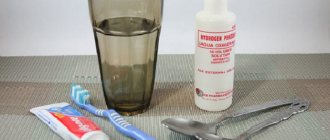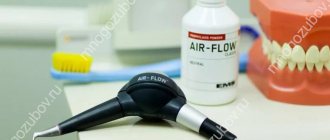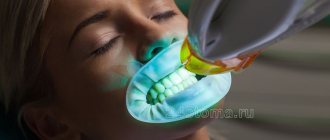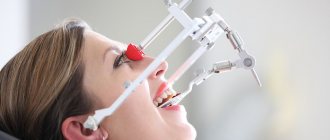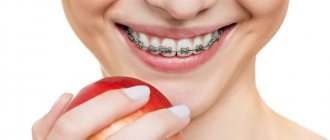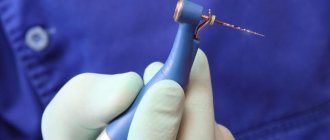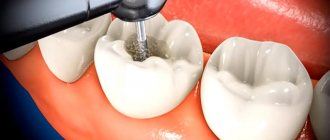Tobacco smoking is a bad habit that has a negative impact on many organs and systems.
First, cigarette smoke enters the oral cavity and affects the human dental apparatus, as well as the soft tissues of the mouth. The consequences of long-term smoking include the formation of unaesthetic plaque, the development of a number of diseases, and poor recovery after dental procedures. The St. Petersburg dental clinic “Nurimed” offers assistance in cleaning teeth from smoking Experienced dentists will take on cases of any complexity and severity. You can sign up for a consultation by calling +7 or by contacting the administrators via online chat.
How does smoking affect teeth?
Tobacco smoke contains a large number of toxic substances harmful to the body. Almost all of them negatively affect the condition of the dentition. Main smoke components:
- nicotine;
- carbon monoxide;
- hydrocyanic acid;
- carbonic acid;
- benzene compounds;
- various oxides;
- hydrogen sulfide;
- acetone;
- carcinogenic substances;
- aldehyde compounds and some other substances in small concentrations.
The first thing that affects a smoker’s teeth is hot smoke, which has a negative effect on tooth enamel. Then toxic substances settle in the oral cavity, causing a traumatic effect.
Condition of teeth in a smoker
The dentition of a smoker has characteristic changes that occur with prolonged use of cigarettes in large quantities:
- Formation of tartar containing tobacco combustion products in large quantities.
- The gums become looser, which leads to the gradual progressive formation of periodontal pockets. Food debris accumulates in these cavities, increasing the risk of developing an infectious process.
- The effect of smoking on teeth is the severe destruction of enamel, which begins with microscopic damage and ends with deep cracks.
- Gradual destruction of the tooth from the inside. In advanced cases, pieces may break off when chewing solid food.
- Reducing the size of crowns and expanding the distances between them due to sedimentation of the mucous membrane. Gradual loosening of teeth followed by their loss.
Gradual damage to the dentofacial apparatus progresses and spreads beyond the oral cavity, affecting the larynx.
Why do smokers get toothache?
The destructive effect on tooth enamel leads to toothache from smoking . The mechanism of pain is associated with several factors:
- increased overall sensitivity due to thinning of the enamel;
- inflammation of the gums due to the penetration of bacteria;
- development of pulpitis (inflammation affecting the root).
Increased sensitivity leads to the fact that a person feels pain when eating foods that are too cold or hot, sweet, sour, or overly spicy foods. Gradually, the situation worsens, then any impact on the damaged enamel begins to cause pain.
How does smoking affect your gums?
The effect of smoking on teeth includes pathological processes in the soft tissues of the oral cavity. Tobacco smoke causes narrowing of small vessels - capillaries in the gums. Because of this, they become pale and are poorly supplied with oxygen and nutrients. An inflammatory process gradually develops, which may be accompanied by:
- bleeding;
- itching;
- purulent discharge;
- bad breath;
- pain and redness of the gums;
- swelling of soft tissues.
The condition progresses, causing teeth to become loose, even if they are not affected by caries.
How smoking affects teeth and gums
Question: “Does smoking affect teeth?” has long ceased to be rhetorical. A harmful addiction is dangerous to health and can lead to various negative consequences.
First of all, the tissues of enamel, gums, tongue and oral mucosa are injured. This causes the appearance of stomatitis, ulcers, wounds, erosions and various inflammations, through which pathogens penetrate into the tissues and begin to multiply there.
Harmful substances negatively affect the functioning of the salivary glands (cells slow down secretion).
Saliva contains bactericidal components, therefore, when natural fluid in the oral cavity decreases, two negative aspects are observed at once:
- local immunity decreases;
- humidity decreases.
The high temperature of tobacco smoke leads to the appearance of microcracks into which tar substances and bacteria enter. In the first case, the teeth begin to turn yellow even in the deep layers of enamel, and in the other, pathogenic microorganisms easily penetrate into the cut gaps, giving rise to caries.
Important. Heavy smokers are at a higher risk of cancer. It can develop both in the lungs and in the oral cavity. Smoking is one of the common causes of malignant gum tumors.
How do wounds in the mouths of smokers heal?
The effects of smoking on your teeth and mouth go beyond poor appearance and unpleasant symptoms.
Unfortunately, tobacco smoke also aggravates other oral diseases that are not directly related to it. Any wound surfaces in the mouth take much longer to heal in smokers. The reason lies in the fact that normal regeneration requires a good blood supply. Only competent recommendations from an experienced dentist will help avoid a number of complications associated with this. In advanced cases, there is a high risk of infection and the development of chronic inflammation.
Possible oral diseases in smokers
Long-term daily smoking of cigarettes contributes to the occurrence of the following pathological conditions:
- Dark coating. Smoking contributes to the formation of dark brown plaque on the teeth, which cannot be removed on your own. The problem is associated with the deposition of cadmium sulfate on the teeth, which is part of tobacco smoke.
- Gingivitis. An inflammatory process affecting the gums. The most common disease among smokers. Accompanied by bleeding during cleaning, redness and swelling.
- Periodontitis. Inflammation of the soft tissues around the tooth up to the bone, involving it in the process. Pain, even during acute infection, is not as severe as in non-smokers, as is bleeding. That is why the problem is noticed already at the stage of loosening, when it is much more difficult to treat.
- Melanosis. Formation of dark spots on the mucous membranes of the oral cavity.
- Stomatitis caused by nicotine. Inflammation of the oral mucosa with the formation of a whitish coating, swelling of the soft tissues and symptoms of irritation.
- Dry mouth. The syndrome develops due to the effects of smoke on the salivary glands and their dysfunction. The process is irreversible, so a person’s taste gradually changes.
- Leukoplakia. A precancerous condition in which the appearance of mucosal cells changes. A smoker develops white nodules on the lips, inner surface of the cheeks, tongue, and palate.
- Leukokeratosis. Another precancerous disease associated with dysplasia of the epithelium on the lips, at the site of contact with a cigarette.
Quitting smoking and brushing your teeth daily can minimize the likelihood of developing oral diseases. It should be borne in mind that a bad habit not only increases the risk of developing the disease, but also slows down its treatment and leads to complications.
How does tobacco affect the oral mucosa?
The teeth of a healthy person and a smoker also differ in that the latter are much more likely to have problems with the oral mucosa. The mildest of these are dry mouth (xerostomia) and an unpleasant odor, which increases due to the breakdown of components of tobacco products. Due to inhalation of hot smoke, tobacco stomatitis and leukoplakia often occur - compacted spots on the mucous membrane, framed by a white coating. In heavy smokers, doctors often diagnose leukokeratosis, which manifests itself in the form of seals (usually on the lower lip). This disease may well be a precursor to cancer, since the tumor often becomes malignant over time. Smoking often becomes one of the causes of gingivitis and periodontitis, and also significantly complicates the treatment of any inflammatory processes in the periodontium.
Plaque on teeth from smoking. How to remove?
Almost all smokers develop dark plaque on their teeth, which spoils their smile. You can't get rid of it with a toothbrush. It is necessary to carry out professional whitening, provided there are no contraindications. The clinic uses several techniques:
- Removing tartar and cleaning the surface from plaque using ultrasound.
- Gentle laser whitening that does not affect the enamel.
- Using a special gel that, under the influence of ultraviolet light, breaks down plaque.
Since whitening a smoker’s teeth is not an easy procedure that requires high qualifications and extensive experience, be careful when choosing a clinic.
Preventing smoker's plaque
In order to reduce the likelihood of smoker plaque forming on your teeth in the future, it is worth systematically reducing the number of cigarettes you smoke per day.
For constant oral hygiene, it is recommended to use special products created specifically for those who smoke. Preventive toothpastes, gels and rinses help remove bacteria and additionally have a deodorizing effect.
If a person continues to abuse tobacco, brushes his teeth irregularly or incorrectly, or does not go to a hygienist for preventive maintenance, smoker’s plaque on his teeth will reappear. Therefore, if you cannot give up cigarettes, take care of high quality hygiene.
You can remove smoker's plaque at the Doka-Dent clinic in Moscow. To do this, sign up for the procedure on the website or by phone.
Smoking after dental implantation
Dental implantation is one of the most common prosthetic methods, which allows you to achieve an ideal aesthetic and functional result. There are many reasons why you should give up a bad habit during the procedure and recovery:
- slowing down the rate of healing of wound surfaces after implant installation;
- slower engraftment of the implant in the bone tissue, as well as an increased risk of rejection;
- increased risk of infection and development of pain syndrome;
- negative impact on the appearance and functional properties of the crown after installation.
Smoking harms not only natural teeth, but also artificial crowns, gradually affecting their color. A bad habit causes the structure to serve less than it should. You have to change crowns more often, which are not cheap.
Negative effects of smoking
Smoking destroys teeth
The health of teeth and gums will gradually deteriorate as harmful components accumulate. First, in about the first two years, the enamel will turn yellow and microcracks will appear.
This is a favorable environment for microbes, so your breath will smell, to put it mildly, not fresh even a short time after brushing your teeth. Subsequently, depending on the immune system and individual characteristics of the body, various diseases will gradually begin to develop, the most dangerous of which is squamous cell carcinoma.
Therefore, it is important to understand that the price paid for a pack of cigarettes in certain cases can be equal to a human life. The table below shows the main negative consequences of regular oral hygiene with tobacco smoke.
Table. Harm of smoking to teeth:
| Pathology | A comment |
| Cadmium sulfate is deposited on top of the enamel, which is formed after contact of smoke and protein components contained in saliva. As a rule, it first appears on the inner surface of the lower teeth, but then the upper ones also turn yellow, then the lips and mucous membranes of the mouth. |
| An unpleasant odor is the result of the accumulation of combustion products in saliva and various parts of the oral cavity, as well as sulfurous secretions of bacteria. Hot smoke dries the mucous membranes and inhibits the activity of the salivary glands. This leads to xerostomia. Such processes are practically irreversible, and a person will feel a burning sensation and distortion of taste due to changes in the functioning of the receptors. |
| Inflammation of the gums and bones is not uncommon among smokers. Quite often, pathogenesis occurs without pain and bleeding. The teeth first become loose and then fall out. In this case, therapy will not be effective unless you give up the bad habit. |
| The formation of dark brown pigment spots on the mucous membranes of the mouth and gums. Often there is an unpleasant odor and yellow plaque present in parallel. The danger is that delicate epithelial tissues can be significantly transformed. |
| It is more often registered in older people in the form of a characteristic seal on the lips when a cigarette is smoked to the ground. If lesions form, tissue examination is required to differentiate from cancer. |
| Formed at the beginning of smoking. Symptoms: redness of the palate due to vasodilatation. As you get used to it, the mucous membranes become thicker, and a characteristic white coating forms. This is especially common among pipe and cigar smokers due to inhalation of hotter smoke. |
| The formation of painful white lumps with an uneven surface (observed even in the early stages of smoking) on various parts of the mucous membranes, which is due to the negative effect of nitrosamines inhaled with smoke. This pathology refers to precancerous conditions. |
Note. The risks of developing cancer pathologies are quite high in people who smoke a pack of cigarettes every day, but if they drink a liter or more of alcoholic beverages per week, the likelihood of cancer increases many times over.
Smoking after tooth extraction
Modern dentistry offers effective and painless methods of tooth extraction. Patients do not experience any discomfort during the procedure, but they are still worried and cannot resist smoking a cigarette after the treatment is completed.
However, dentists believe that smoking and dental health are incompatible things.
Cigarettes after removing affected teeth, especially if we are talking about wisdom teeth, can cause complications. In addition, tobacco smoke has an irritating effect on the wound surface, causing pain and aggravating inflammation. Smokers are advised to abstain from the habit at least in the first day after removal, and better yet, until complete healing.
Preventive actions
The most effective prevention of pathological changes is giving up the bad habit. If this is not possible, then the following recommendations will help reduce the destructive effects of tobacco smoke:
- Careful, daily personal hygiene. It is recommended to brush your teeth after each meal, use dental floss, and mouthwash.
- Preventive examinations at the dentist with professional cleaning, including whitening. You need to visit a doctor 1-2 times a year to remove tartar and plaque and identify inflammation and infection in the early stages.
- If you cannot completely quit smoking, then you need to at least reduce the number of cigarettes you smoke per day. We are talking not only about the condition of the mouth, but also the impact on the entire body as a whole.
Since to restore teeth after smoking , you should choose a trusted clinic. Dentistry "Nurimed" offers services for whitening, removal, restoration, prosthetics and other types of oral treatment for smokers. The center’s specialists will help you regain psychological comfort and physical health, lost due to the effects of smoking on your teeth.
Oral hygiene for smokers
In this article, we are not intimidating smokers or trying to convince them to quit this harmful habit. We just give some useful oral care tips to patients who have smoking problems.
Smoker's oral health
A little theory All smokers probably notice warnings on packs that indicate an increased risk of developing gum disease. And this is true: numerous studies prove that periodontal disease occurs 2-5 times more often in smokers than in those who do not smoke. This occurs due to the vasoconstrictor effect of nicotine on the oral mucosa, as a result of which blood flow in the periodontal tissues slows down and saliva formation decreases. Saliva in the mouth is an important element that, among other things, helps inhibit the growth of pathogenic bacteria. Reduced salivation + toxic substances in tobacco contribute to the accumulation and active reproduction of pathogenic bacteria in the oral cavity, which ultimately leads to periodontal (gum) inflammation.
Oral care for smokers ? Smokers often actively use bleaching pastes, as well as pastes for smokers, which contain hydrogen peroxide and abrasives. Such toothpastes can thin tooth enamel and increase tooth sensitivity, which aggravates the situation in the oral cavity. Dentists advise smokers to use special pastes alternately with regular hygienic paste. It is also a good idea to use antiseptic or antibacterial pastes. ? For better cleaning, in addition to toothbrushes, dental floss, brushes, gels and rinses can be offered. A set of hygiene products should be selected by a doctor individually for each patient, depending on the condition of his oral cavity and the severity of the inflammatory process. ? The mucous membranes of the oral cavity should not be allowed to become dry. To stimulate salivation, you need to drink 1.5-2 liters of water per day and you can use chewing gum without sugar? macaw ? To “refresh” the color of your teeth, you need to have your teeth professionally cleaned twice a year using ultrasound and an Air-flow device. In addition, during the procedure, the dentist will be able to pay attention to subgingival deposits, and, if necessary, refer the patient for periodontal treatment: clean the roots of the tooth, cure pathological pockets, splint mobile teeth, prescribe antibiotics, anti-inflammatory procedures, etc.
Compliance with these simple but mandatory hygiene rules will be an excellent prevention of periodontal disease in smokers.
